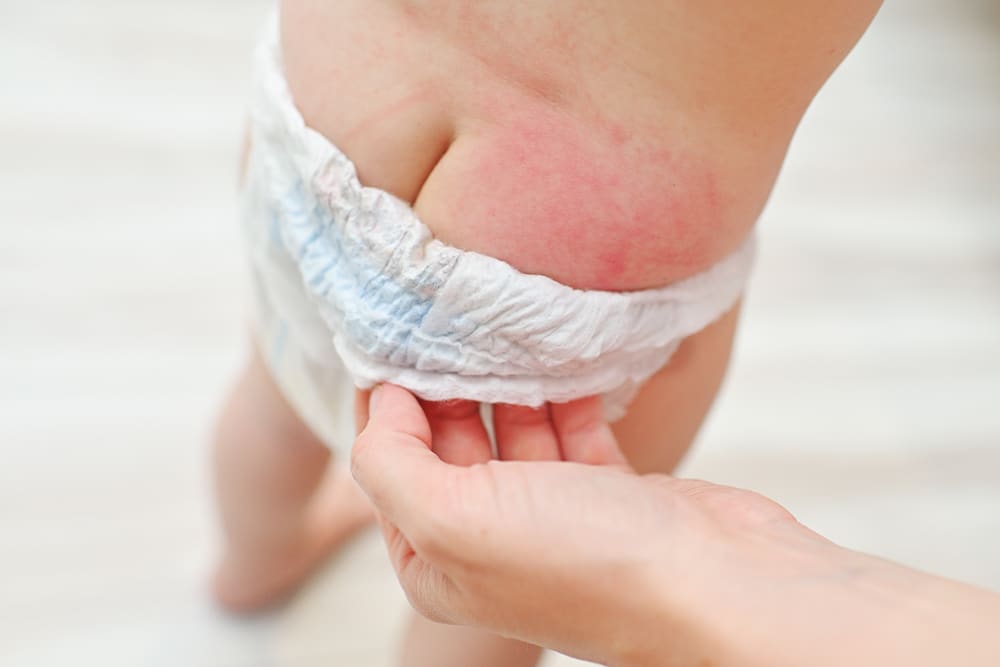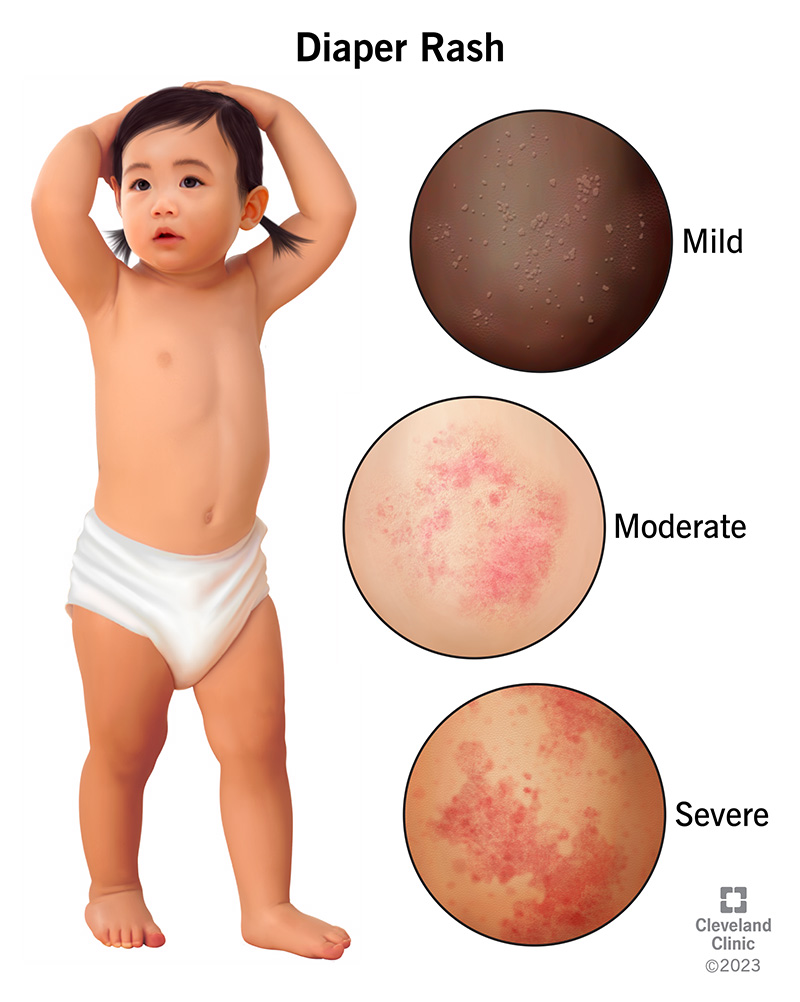The best way to help a baby diaper rash is to keep the area clean and dry. Apply a barrier cream to protect the skin.
Diaper rash is a common issue for infants, causing discomfort and irritation. Ensuring proper hygiene can significantly reduce the risk and severity of the rash. Frequent diaper changes and allowing the baby’s skin to breathe are essential. Using mild, fragrance-free wipes or warm water to clean the diaper area helps avoid further irritation.
Barrier creams, like zinc oxide ointments, create a protective layer on the skin, shielding it from moisture and irritants. Avoiding tight-fitting diapers and opting for breathable materials can also help. Always consult a pediatrician if the rash persists or worsens, as it might require medical attention.

Credit: hmgsderm.com
Common Causes
Understanding the common causes of baby diaper rash can help you prevent it. Diaper rash can make your baby uncomfortable and cranky. Knowing why it happens is the first step in treating and preventing it.
Irritants
Diaper rash often occurs because of irritants. These irritants can include wet diapers, stool, and urine. When a baby’s skin stays in contact with these irritants, it can cause redness and soreness.
Using fragrant wipes or lotions can also irritate a baby’s skin. Always choose products labeled as hypoallergenic and fragrance-free. This reduces the risk of irritation.
Allergies
Allergies can also lead to diaper rash. Babies may be allergic to certain foods or products. Common allergens include certain baby wipes, detergents, and even diapers themselves.
Watch for signs of an allergic reaction, such as raised bumps or extreme redness. If you suspect an allergy, try switching to a different brand or product.
Infections
Infections can cause severe diaper rash. Yeast infections are a common type of infection that affects babies. These infections thrive in warm, moist environments like diapers.
Bacterial infections can also cause diaper rash. These are usually more severe and may require medical treatment. Look for signs like pus or yellow crusting.
| Cause | Signs | Solutions |
|---|---|---|
| Irritants | Redness, soreness | Use fragrance-free products |
| Allergies | Raised bumps, extreme redness | Switch brands/products |
| Infections | Pus, yellow crusting | Seek medical treatment |
Prevention Tips
Diaper rash can be a painful experience for babies. Prevention is always better than cure. Follow these prevention tips to keep your baby comfortable and rash-free.
Frequent Changes
Changing diapers frequently can help keep your baby’s skin dry. Wet or soiled diapers are the main causes of diaper rash. Aim to change the diaper every 2-3 hours. Always check the diaper after your baby eats.
Proper Cleaning
Proper cleaning is essential to prevent diaper rash. Use warm water and a soft cloth for cleaning. Avoid using wipes with alcohol or fragrances. Pat the skin dry gently. Do not rub the skin as it can cause irritation.
Diaper-free Time
Allow your baby some diaper-free time. Fresh air helps the skin breathe and stay dry. Lay a soft towel on the floor and let your baby enjoy some diaper-free moments. Try to give diaper-free time at least once a day.
Additional Tips:
- Use a barrier cream to protect the skin.
- Choose diapers that are highly absorbent.
- Avoid tight-fitting diapers and clothes.
Choosing The Right Diaper
Choosing the right diaper is essential for preventing diaper rash. The wrong diaper can irritate your baby’s sensitive skin. This guide will help you select the best diaper for your baby.
Material Matters
The material of the diaper greatly impacts your baby’s comfort. Choose diapers made from soft, hypoallergenic materials. Avoid diapers with harsh chemicals and fragrances. These can cause skin irritation.
Look for diapers with natural fibers. Cotton is a great option. It is breathable and gentle on the skin. Bamboo is another excellent choice. It is naturally hypoallergenic and very absorbent.
Size And Fit
The right size ensures the diaper fits well. A poorly fitting diaper can cause chafing and rash. Check the weight guidelines on the diaper package. Make sure it matches your baby’s weight.
A snug fit around the legs and waist is important. It prevents leaks and reduces friction. Avoid diapers that are too tight. This can cause red marks and discomfort.
Here is a simple size chart:
| Weight (lbs) | Diaper Size |
|---|---|
| Up to 10 | Newborn |
| 8-14 | Size 1 |
| 12-18 | Size 2 |
| 16-28 | Size 3 |
Breathability
Breathability is crucial for keeping your baby’s skin dry. Choose diapers with breathable materials. This allows air to circulate around the diaper area. It helps to keep the skin dry and cool.
Look for diapers with air channels. These features enhance airflow. They can significantly reduce the risk of diaper rash. Avoid plastic-backed diapers. They trap moisture and heat, leading to irritation.
In summary, choose diapers made from soft, hypoallergenic materials. Ensure they fit well and are breathable. This reduces the risk of diaper rash and keeps your baby comfortable.

Credit: my.clevelandclinic.org
Effective Home Remedies
Baby diaper rash can be distressing for both babies and parents. Luckily, there are effective home remedies to soothe and heal the rash. These remedies are natural, safe, and easy to find. Below, we explore some of the best solutions that can provide relief for your little one.
Aloe Vera
Aloe Vera is a powerful healing agent. Its natural properties can soothe irritated skin. Apply a thin layer of pure Aloe Vera gel to the affected area. Ensure the gel is free from any added chemicals or fragrances. Aloe Vera helps reduce inflammation and speeds up the healing process.
Coconut Oil
Coconut oil is another excellent remedy for diaper rash. It has antibacterial and antifungal properties. Gently massage a small amount of coconut oil onto the rash. This creates a protective barrier on the skin. It also moisturizes and soothes irritation.
- Choose organic, unrefined coconut oil.
- Apply after every diaper change.
- Use a clean finger or cotton swab for application.
Oatmeal Baths
An oatmeal bath can provide significant relief for diaper rash. Oatmeal contains compounds that have anti-inflammatory properties. To prepare an oatmeal bath:
- Grind plain, unsweetened oatmeal into a fine powder.
- Add one cup of this powder to a warm bath.
- Let your baby soak for 10-15 minutes.
This method helps soothe irritated skin and reduces redness. Make sure to pat your baby dry gently after the bath.
Over-the-counter Solutions
Diaper rash is a common problem for babies. Over-the-counter solutions can offer quick relief. These products can soothe irritated skin and reduce redness. Let’s explore some effective options.
Barrier Creams
Barrier creams create a protective layer on the skin. They prevent moisture from causing further irritation. Popular ingredients include zinc oxide and petrolatum. These creams are easy to apply and effective.
- Zinc oxide creams are thick and long-lasting.
- Petrolatum forms a moisture barrier.
- Apply a thin layer after each diaper change.
Antifungal Ointments
If the rash persists, it could be a yeast infection. Antifungal ointments can help. These ointments target the fungal infection directly. Common ingredients include clotrimazole and miconazole.
| Ingredient | Benefits |
|---|---|
| Clotrimazole | Effective against yeast infections. |
| Miconazole | Reduces fungal growth and irritation. |
Hydrocortisone Cream
For severe diaper rashes, hydrocortisone cream may be necessary. This cream reduces inflammation and itching. It is important to use it sparingly. Hydrocortisone can thin the skin if overused.
- Use a small amount.
- Apply only to affected areas.
- Follow the advice of a healthcare professional.
These over-the-counter solutions can help manage diaper rash effectively. Always consult with a pediatrician for persistent rashes.
When To See A Doctor
Diaper rash is common in babies and usually treatable at home. Yet, there are times you need to see a doctor. Knowing when to seek medical help is crucial for your baby’s health. Below are some signs that indicate it’s time to consult a healthcare professional.
Persistent Rashes
If your baby’s diaper rash lasts more than a few days, it’s a concern. Typically, rashes improve with home treatment. If the rash persists despite your efforts, consult your pediatrician. Continuous rashes could be a sign of an underlying issue.
Blisters Or Pus
Blisters or pus on your baby’s skin are warning signs. These symptoms suggest a possible infection. Infected rashes need medical treatment to prevent complications. A doctor can prescribe the right medication to treat infections effectively.
Fever
If your baby develops a fever along with a diaper rash, seek medical advice. Fever might indicate a more serious infection. It’s important to address both the rash and the fever promptly. A healthcare professional can guide you on the best course of action.
Alternative Diaper Options
Dealing with diaper rash can be stressful for both babies and parents. Exploring alternative diaper options can make a big difference in managing and preventing diaper rash. Here are some effective alternatives that can be kinder to your baby’s skin.
Cloth Diapers
Cloth diapers are soft and breathable, reducing irritation. They are made from natural materials like cotton. This makes them gentle on a baby’s skin. Cloth diapers are reusable and can be washed easily. They come in various styles, including pre-folds, fitted, and all-in-ones. Here’s a quick comparison:
| Type | Features |
|---|---|
| Pre-folds | Simple and cost-effective |
| Fitted | Shaped like disposables, but reusable |
| All-in-ones | Easy to use, no folding needed |
Parents can choose based on convenience and budget. Cloth diapers need more frequent changes to keep the skin dry.
Biodegradable Diapers
Biodegradable diapers are eco-friendly and made from natural materials. They decompose faster than regular disposable diapers. These diapers are free from harsh chemicals and dyes. This reduces the risk of skin irritation and allergic reactions. Biodegradable diapers are also a great choice for environmentally-conscious parents.
- Made from plant-based materials
- Compostable and break down quickly
- Gentle on sensitive skin
They may cost more but are worth considering for their benefits.
Disposable Diapers
Disposable diapers are convenient and widely available. They come in various sizes and styles. Some brands offer hypoallergenic and fragrance-free options. These are better for babies with sensitive skin. Disposable diapers often have excellent absorbency. This keeps the skin dry and minimizes the risk of diaper rash.
- Hypoallergenic options
- Fragrance-free choices
- High absorbency levels
Parents should look for diapers with breathable outer layers. This helps in reducing moisture buildup.
Choosing the right diaper can significantly help in managing diaper rash. Each type has its own benefits. Parents should consider their baby’s needs and their own preferences.
Maintaining Skin Health
Maintaining your baby’s skin health is essential to prevent diaper rash. Proper care ensures their skin stays soft and free from irritation.
Moisturizing
Moisturizing your baby’s skin is vital. Use a gentle, fragrance-free moisturizer. Apply it after every diaper change. This keeps the skin hydrated and protected.
Avoid products with harsh chemicals. Natural oils like coconut oil can also be effective. They soothe the skin and form a protective barrier.
Hydration
Keeping your baby hydrated is crucial. Ensure they drink enough fluids. Hydration supports overall skin health.
Breast milk and formula provide necessary hydration. For older babies, offer water and natural juices. Avoid sugary drinks as they can cause skin issues.
Balanced Diet
A balanced diet is important for healthy skin. Include fruits, vegetables, and whole grains in their meals. These foods are rich in vitamins and minerals.
Monitor any food allergies. Some foods can trigger skin reactions. Consult with your pediatrician for a proper diet plan.

Credit: www.thepediatricianmom.com
Frequently Asked Questions
What Causes Baby Diaper Rash?
Diaper rash can be caused by prolonged exposure to wet diapers, friction, and sensitive skin. Irritants such as soaps and wipes can also contribute.
How Can I Prevent Diaper Rash?
To prevent diaper rash, change diapers frequently, use a gentle cleanser, and apply a barrier cream. Keep the diaper area dry and clean.
What Home Remedies Help Diaper Rash?
Home remedies for diaper rash include airing out the skin, using oatmeal baths, and applying coconut oil. Always consult your pediatrician.
Is Diaper Rash Cream Effective?
Yes, diaper rash cream is effective. It forms a barrier to protect the skin and promotes healing. Choose a cream with zinc oxide.
Conclusion
Caring for baby diaper rash requires gentle, effective methods. Use fragrance-free products and ensure the diaper area stays dry. Always consult a pediatrician if the rash persists. Following these tips can help your baby stay comfortable and rash-free. Prioritize your baby’s skin health for their overall well-being.




